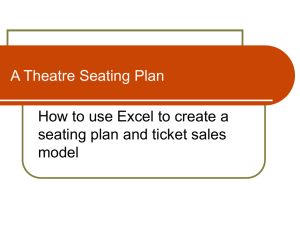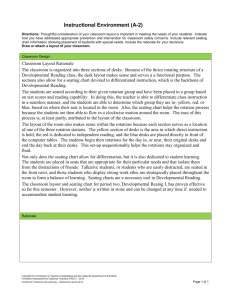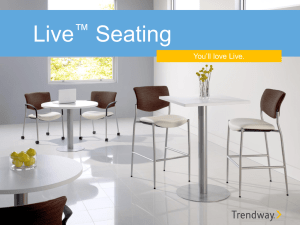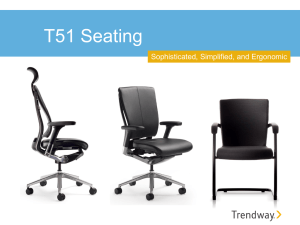I-5 Tool Managing Classroom Space
advertisement
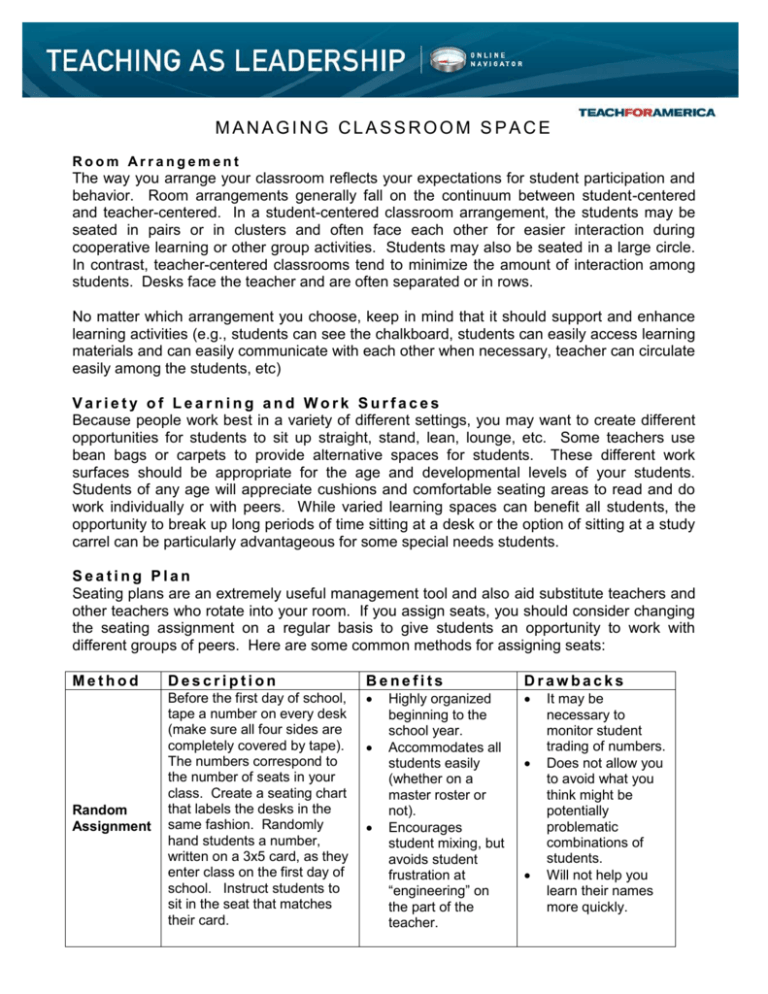
MANAGING CLASSROOM SPACE Room Arrangement The way you arrange your classroom reflects your expectations for student participation and behavior. Room arrangements generally fall on the continuum between student-centered and teacher-centered. In a student-centered classroom arrangement, the students may be seated in pairs or in clusters and often face each other for easier interaction during cooperative learning or other group activities. Students may also be seated in a large circle. In contrast, teacher-centered classrooms tend to minimize the amount of interaction among students. Desks face the teacher and are often separated or in rows. No matter which arrangement you choose, keep in mind that it should support and enhance learning activities (e.g., students can see the chalkboard, students can easily access learning materials and can easily communicate with each other when necessary, teacher can circulate easily among the students, etc) Variety of Learning and Work Surfaces Because people work best in a variety of different settings, you may want to create different opportunities for students to sit up straight, stand, lean, lounge, etc. Some teachers use bean bags or carpets to provide alternative spaces for students. These different work surfaces should be appropriate for the age and developmental levels of your students. Students of any age will appreciate cushions and comfortable seating areas to read and do work individually or with peers. While varied learning spaces can benefit all students, the opportunity to break up long periods of time sitting at a desk or the option of sitting at a study carrel can be particularly advantageous for some special needs students. Seating Plan Seating plans are an extremely useful management tool and also aid substitute teachers and other teachers who rotate into your room. If you assign seats, you should consider changing the seating assignment on a regular basis to give students an opportunity to work with different groups of peers. Here are some common methods for assigning seats: Method Random Assignment Description Benefits Drawbacks Before the first day of school, tape a number on every desk (make sure all four sides are completely covered by tape). The numbers correspond to the number of seats in your class. Create a seating chart that labels the desks in the same fashion. Randomly hand students a number, written on a 3x5 card, as they enter class on the first day of school. Instruct students to sit in the seat that matches their card. Highly organized beginning to the school year. Accommodates all students easily (whether on a master roster or not). Encourages student mixing, but avoids student frustration at “engineering” on the part of the teacher. It may be necessary to monitor student trading of numbers. Does not allow you to avoid what you think might be potentially problematic combinations of students. Will not help you learn their names more quickly. Create a seating chart that places students in alphabetical order, and place nametags on student desks. Alphabetical If you have several different Assignment classes of students, tape onto the desks an index card that lists each class period and the assigned student’s name next to the class period. Students are free to choose their seats as they enter class . (Freedom to choose one’s seat can also be a reward for positive behavior). Alphabetical placement makes it easier for some teachers to learn students’ names. Students may be more social because it is likely that they have been seated alphabetically in the past. Enables student choice, which may encourage a level of comfort in the classroom. Students may be more social because it is likely that they will sit with their friends. It may be difficult to learn students’ names quickly if they constantly choose new seats. There will be no set chart for substitute teachers. Doing this at the beginning of the year does not consider students entering class without being on the master list (to address this situation, ask new students to create their own name card and sit at an open desk). Students may interpret teacher’s seating decisions as unfair. CC Student Choice Teacher Assigned Once you get to know students, you should create a seating chart that thoughtfully places individual students. Create and place nametags on the desks, according to your seating chart. If you have several different classes of students, tape an index card onto the desk that lists each class period and the assigned student’s name next to the class period. Ask students to find their seats as they enter class. Allows teacher to be strategic about placement. If you do this at the beginning of the year, it may help you learn their names more quickly, as you can note their names as you walk around the classroom. Your seating plan should also take into account individual students’ special needs. Students with vision problems, for instance, should be seated close to the board; students with limited English skills could be seated next to bilingual students; and a student who has particular trouble concentrating could be seated in a desk away from peers but near the teacher. On your parent or student survey, you might ask, “Do you need to sit in a special seat for any reason? (to hear better, to see better, etc.)” Personal Space Many students need personal space in order to feel that they belong to the classroom and that they can keep their personal belongings safe. In addition to personal desk space, students may benefit from having their own mailbox, folders, or space to display their student work. You may create these items or have the students create them themselves. Displays Visual displays are an important aspect of a classroom environment that supports student learning. In addition to posting classroom rules and procedures and other important notices, displays are a great opportunity to focus your students on their academic goals, reinforce the material that you are teaching, and create a print-rich environment conducive to developing your students’ literacy skills. If the displays are directly related to your curriculum, they can enhance your lessons and foster greater independence in your students. For example, a middle school math teacher could post diagrams of geometric shapes and the formulas for their areas, volumes, and surface areas. The teacher could then utilize the diagrams while teaching a lesson on the subject, and students could independently refer to them when solving problems in class. (Keep in mind that you may want to cover such displays during tests and quizzes if you do not want students to reference them.) As a side note, displays may have the added advantage of focusing a student on relevant material even when his or her attention is diverted from the task at hand! Students can also be figuratively transported to another place through the strategic use of displays. For example, an elementary class that is studying the rain forest could turn the classroom into a rain forest, complete with paper replications of the plants, animals, and terrain that the students are learning about. A French teacher could make his or her classroom into “Paris,” so that the students’ language lesson is visually reinforced by graphic, cultural information. In addition to posting material that reinforces your curriculum, displaying student work sends an important message. Such displays help build a sense of identity and belonging and create a lively classroom environment where learning is relevant and valued. In addition, student work displays celebrate hard work. Student input and assistance in decorating the room will help to give students a sense of ownership of the learning environment. Finally, the creation of a print-rich environment through displays enhances literacy instruction across grade levels and content areas. Consider creating a word wall, with vocabulary words from the different subjects you are currently studying, words that students have found in their independent reading, a word of the day supplied by students, etc. A weekly poem on chart paper or a thought for the week can provide “unofficial” new vocabulary and sight words for students. Checklist for Classroom Organization Can all students see the board? Do you separate active areas and quiet areas? Yes Yes No No Does your room have clear and safe traffic paths? Yes Do you have areas devoted to enrichment? Yes Have you considered where you will put your desk? Yes Have you arranged the desks to enable quick and easy monitoring? Yes No No No No Are the pencil sharpener and trash can accessible? Are student materials stored visibly and accessible? Have you determined a seating chart? Do students have a place they can call their own? Do you have a display area for student work? No No No No No Yes Yes Yes Yes Yes
